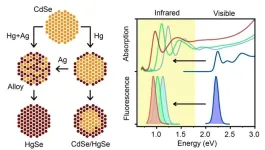(Press-News.org) Osteoarthritis—a condition in which the protective cartilage on the ends of bones breaks down—may more than double the risk of speedy progression to accumulating severe long term conditions (multimorbidity), finds a 20 year study published in the open access journal RMD Open.
And there seem to be 4 different speeds of progression to multimorbidity, the findings indicate.
Persistently low levels of physical activity, a high calorie diet, plus chronic low grade inflammation may help to explain the link between osteoarthritis and the risk of accumulating other long term conditions, suggest the researchers.
Although the exact causes aren’t known, injury, age, family history, and female sex are all thought to be contributory factors to the development of osteoarthritis, which affects more than 500 million people globally.
Around 7 out of 10 of those affected are likely to have other long term conditions, but it’s not clear how quickly these develop, or how severe they are, say the researchers.
In a bid to find out, they drew on continuously collected healthcare data for the Skåne region of Sweden (around 1.4 million residents) and extracted diagnoses for osteoarthritis and 67 common long term conditions.
They focused on those aged at least 40 on 31 December 2007, who had lived in the region since 1998, and who had been newly diagnosed with osteoarthritis between 2008 and 2009. This added up to a total of 9846 people with an average age of 66 (58% women).
Each of these cases was matched with two people of the same age and sex who didn’t have osteoarthritis (reference group) adding up to a total of 19692 people.
The cumulative number of conditions (multimorbidity) from 1998 onwards was tracked among the cases and their matched counterparts until death, relocation outside the region, or the end of 2019, whichever came first.
Some 5318 people were newly diagnosed with knee osteoarthritis, 2479 with hip osteoarthritis, 988 with hand osteoarthritis, 714 with osteoarthritis in other joints, and 499 with generalised osteoarthritis between 2008 and 2009.
Some 1296 people (cases and reference group participants) didn’t develop any other long term condition. But 28,242 people did.
Four different patterns of progression emerged between 1998 and 2019: mild multimorbidity late progression (class 1); mild multimorbidity early progression (class 2); moderate multimorbidity (class 3); and severe multimorbidity (class 4).
In 1998 the average number of long term conditions was low (1 or none) in all 4 classes. And those in class 1 progressed the most slowly to developing several long term conditions and had the lowest cumulative total at the end of the tracking period, with an average of around 3.
There was little or no development of long term conditions for around 10 years among those in this category, followed by more rapid progression that brought them on a par with people in class 2. In general, those in classes 1 and 2 tended to be younger and better educated.
Those in class 4, on the other hand, progressed the fastest and had the highest cumulative total of around 10 long term conditions at the end of the tracking period.
The disability weighting used in the Global Burden of Disease (GBD) study was used to assess the severity of each long term condition, excluding osteoarthritis.
Levels of disability mirrored the categorisations. They were lowest among those in class 1 and highest among those in class 4, where over half (57%) the participants had died by the end of the tracking period.
The prevalence of osteoarthritis was also lowest among those in class 1 (29%) and highest among those in class 4 (42%). And osteoarthritis was associated with a 29% heightened risk of class 1 membership, but a more than doubling in risk for class 4 membership.
The presence of osteoarthritis alone, however, was a poor predictor of any class of membership, the findings showed.
“While this study did not aim to study the timing of [osteoarthritis] diagnosis in relation to multimorbidity, our results suggest that [it] can, in some cases, precede multimorbidity—as it can be observed in mild multimorbidity late progression class—while in others [it] is diagnosed when multimorbidity is already established,” explain the researchers.
“These results suggest that [osteoarthritis] is part of a disease continuum where [it] and other chronic conditions concur to the development of more severe multimorbidity,” they add.
Age is a highly influential factor in the development of long term conditions, point out the researchers. “Nonetheless, the correlation between [osteoarthritis] and multimorbidity remained unaffected, indicating that [its] association with multimorbidity extends beyond age,” they write.
This is an observational study, and as such, no definitive conclusions can be drawn about causal factors. And the researchers acknowledge several limitations to their findings, including that the role of physical activity, diet, and body weight weren’t factored into the various classes.
“Low physical activity, high-calorie diet, and low-grade inflammation have all been advocated as a plausible link between [osteoarthritis] and other chronic diseases and could partially explain the observed associations,” they suggest.
END
Osteoarthritis may double risk of speedy progression to severe multimorbidity
4 different patterns of progression to accumulating long term conditions identified. Unhealthy lifestyle + low grade inflammation may help to explain link, suggest researchers
2024-07-10
ELSE PRESS RELEASES FROM THIS DATE:
Researchers listen to the hearts of bats in flight
2024-07-10
Researchers from Konstanz have measured the heart rate of bats over several days in the wild, including complete flights—the first time this has been done for a bat species. To record the heart rate of male common noctule bats during flight, the scientists attached heart rate transmitters weighing less than one gram to the animals, which they then accompanied in an airplane while the bats flew, sometimes for more than an hour, in search of food. Their results, published in Proceedings of the Royal Society B, show how much energy bats consume over the course of a day and what energy-saving strategies they ...
Familial endocrine diseases linked to increased risk of pregnancy loss, new research shows
2024-07-10
Women who have close family members with endocrine diseases, including type 2 diabetes, thyroid diseases and polycystic ovary syndrome (PCOS), are at higher risk of pregnancy loss, a new study has found [1].
The research, presented today at the ESHRE 40th Annual Meeting in Amsterdam, examined the association between various endocrine diseases and the incidence of pregnancy loss. The study investigated 366,539 women in Denmark between 1973 and 2022.
The study found that women with parents diagnosed with endocrine diseases faced a 6% higher risk of pregnancy loss ...
Health AI expert Nathan Price joins Buck faculty
2024-07-09
The Buck Institute for Research on Aging announces the appointment of Nathan Price, PhD, to Professor and Co-Director of the Center for Human Healthspan. Price specializes in systems biology, artificial intelligence, and bioengineering. He has published more than 200 scientific papers and is co-author, with Buck Chief Innovation Officer and Distinguished Professor Lee Hood, of “The Age of Scientific Wellness.” Price has been named one of 10 Emerging Leaders in Health and Medicine by the National Academy of Medicine and is a member of the Board on Life Sciences of the National Academies of Sciences, Engineering, and Medicine.
Dr. Price is Chief Scientific Officer ...
Greater focus needed on how existing international law can prevent the increasing militarisation of outer space
2024-07-09
There is a pressing need for countries and international organisations to understand better how existing international law can help them address serious concerns about the militarisation of outer space, a new study says.
Space ...
Found with Webb: a potentially habitable icy world
2024-07-09
A international team of astronomers led by Université de Montréal has made an exciting discovery about the temperate exoplanet LHS 1140 b: it could be a promising "super-Earth" covered in ice or water.
When the exoplanet LHS 1140 b was first discovered, astronomers speculated that it might be a mini-Neptune: an essentially gaseous planet, but very small in size compared to Neptune. But after analyzing data from the James Webb Space Telescope (JWST) collected in December 2023 - combined with previous data from other space telescopes such as Spitzer, Hubble and ...
New one-step method to make multiple edits to a cell’s genome
2024-07-09
SAN FRANCISCO, CA—Genome editing has become a widely adopted technology to modify DNA in cells, allowing scientists to study diseases in the lab and develop therapies that repair disease-causing mutations. However, with current approaches, it’s only possible to edit cells in one location at a time.
Now, a team of scientists at Gladstone Institutes has developed a new method that enables them to make precise edits in multiple locations within a cell—all at once. Using molecules called retrons, they created a tool that can efficiently modify DNA in bacteria, yeast, and human cells.
“We wanted to push the boundaries of genomic technologies ...
Moving from the visible to the infrared: Developing high quality nanocrystals
2024-07-09
Awarded the 2023 Nobel Prize in Chemistry, quantum dots have a wide variety of applications ranging from displays and LED lights to chemical reaction catalysis and bioimaging. These semiconductor nanocrystals are so small—on the order of nanometers—that their properties, such as color, are size dependent, and they start to exhibit quantum properties. This technology has been really well developed, but only in the visible spectrum, leaving untapped opportunities for technologies in both the ultraviolet and infrared regions of the electromagnetic ...
Implantable LED device uses light to treat deep-seated cancers
2024-07-09
Certain types of light have proven to be an effective, minimally invasive treatment for cancers located on or near the skin when combined with a light-activated drug. But deep-seated cancers, surrounded by tissue, blood and bone, have been beyond the reach of light’s therapeutic effects.
To bring light’s benefits to these harder-to-access cancers, engineers and scientists at the University of Notre Dame have devised a wireless LED device that can be implanted. This device, when combined with a light-sensitive ...
LA County faces dual challenge: Food insecurity and nutrition insecurity
2024-07-09
While food insecurity has long been the focus of local and national policymakers and researchers, nutrition insecurity has largely been overlooked. A new study by the Institute for Food System Equity (IFSE) at the USC Dornsife College of Letters, Arts and Sciences aims to change that.
This is the first study in Los Angeles County to identify the populations most affected by nutrition insecurity, distinct from food insecurity. Nutrition insecurity refers to a lack of access to healthy food that ...
AI can support humanitarian organizations in situations of armed conflict or crisis - but they should understand the potential risks, study warns
2024-07-09
AI can help humanitarians gain crucial insights to better monitor and anticipate risks, such as a conflict outbreak or escalation. But deploying systems in this context is not without risks for those affected, a new study warns.
Humanitarian organisations have been increasingly using digital technologies and the Covid-19 pandemic has accelerated this trend.
AI-supported disaster mapping was used in Mozambique to speed up emergency response, and AI systems were used to predict food crisis and rolled out by the World Bank across twenty-one countries.
But the study warns some uses of AI may expose people to additional harms and present significant ...
LAST 30 PRESS RELEASES:
Interaction of climate change and human activity and its impact on plant diversity in Qinghai-Tibet plateau
From addressing uncertainty to national strategy: an interpretation of Professor Lim Siong Guan’s views
Clinical trials on AI language model use in digestive healthcare
Scientists improve robotic visual–inertial trajectory localization accuracy using cross-modal interaction and selection techniques
Correlation between cancer cachexia and immune-related adverse events in HCC
Human adipose tissue: a new source for functional organoids
Metro lines double as freight highways during off-peak hours, Beijing study shows
Biomedical functions and applications of nanomaterials in tumor diagnosis and treatment: perspectives from ophthalmic oncology
3D imaging unveils how passivation improves perovskite solar cell performance
Enriching framework Al sites in 8-membered rings of Cu-SSZ-39 zeolite to enhance low-temperature ammonia selective catalytic reduction performance
AI-powered RNA drug development: a new frontier in therapeutics
Decoupling the HOR enhancement on PtRu: Dynamically matching interfacial water to reaction coordinates
Sulfur isn’t poisonous when it synergistically acts with phosphine in olefins hydroformylation
URI researchers uncover molecular mechanisms behind speciation in corals
Chitin based carbon aerogel offers a cleaner way to store thermal energy
Tracing hidden sources of nitrate pollution in rapidly changing rural urban landscapes
Viruses on plastic pollution may quietly accelerate the spread of antibiotic resistance
Three UH Rainbow Babies & Children’s faculty elected to prestigious American Pediatric Society
Tunnel resilience models unveiled to aid post-earthquake recovery
Satellite communication systems: the future of 5G/6G connectivity
Space computing power networks: a new frontier for satellite technologies
Experiments advance potential of protein that makes hydrogen sulfide as a therapeutic target for Alzheimer’s disease
Examining private equity’s role in fertility care
Current Molecular Pharmacology achieves a landmark: real-time CiteScore advances to 7.2
Skeletal muscle epigenetic clocks developed using postmortem tissue from an Asian population
Estimating unemployment rates with social media data
Climate policies can backfire by eroding “green” values, study finds
Too much screen time too soon? A*STAR study links infant screen exposure to brain changes and teen anxiety
Global psychiatry mourns Professor Dan Stein, visionary who transformed mental health science across Africa and beyond
KIST develops eco-friendly palladium recovery technology to safeguard resource security
[Press-News.org] Osteoarthritis may double risk of speedy progression to severe multimorbidity4 different patterns of progression to accumulating long term conditions identified. Unhealthy lifestyle + low grade inflammation may help to explain link, suggest researchers





